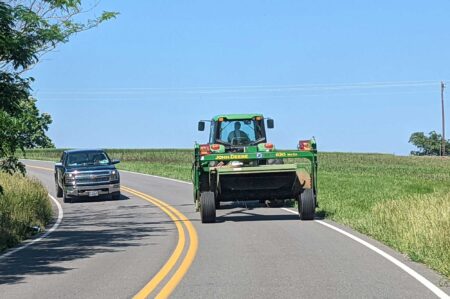Soybean disease season has arrived early across much of the Midwest.
July is usually a quiet time for scouting, but this year, diseases such as frogeye leaf spot, Cercospora, sudden death syndrome, and red crown rot are all appearing sooner, and sometimes farther north, than usual.
“With frequent rains this year, some of the typical August diseases are arriving early,” Daren Mueller, soybean plant pathologist at Iowa State University, wrote in a recent update.
Understanding Risk and the Disease Triangle
While many growers associate disease outbreaks with heavy rainfall, Stephanie Porter, outreach agronomist with the Illinois Soybean Association, cautioned against a false sense of security during dry spells.
“The disease triangle reminds us that it’s not just about rain,” Porter said. “You need three things: a susceptible host, a virulent pathogen, and a conducive environment. And that environment doesn’t have to mean inches of rain — it can simply be high humidity and extended leaf wetness.”
Even in the absence of measurable precipitation, moisture from heavy dews, overhead irrigation, or humid conditions can create ideal conditions for foliar diseases to thrive — especially in fields with dense canopies.
“Dense crop canopies trap moisture,” Porter explained. “Just because it hasn’t rained doesn’t mean the leaf surface isn’t wet for hours at a time. That’s enough to get infection started, if the pathogen is present.”
Porter emphasized that growers should remain vigilant in scouting and not rely solely on weather apps or rainfall totals. “We can’t always see what’s happening within the canopy,” she said. “The microclimate in there may be telling a different story than what the forecast suggests.”
Frogeye Leaf Spot and Cercospora
Albre Brown, technical marketing manager at BASF, reported frogeye leaf spot and Cercospora leaf blight are showing up, fueled by early-season rains and extended humidity. Frogeye, once considered a Southern disease, is now common as far north as Indiana and central Illinois. For soybean seed producers, Cercospora is even more concerning due to its link with purple seed stain and seed quality issues, Brown warned.
Courtesy Provided
According to the Crop Protection Network (CPN), Cercospora leaf blight was estimated to have caused 3.2 million bushels of soybean yield losses in the United States in 2024, one of the top foliar diseases causing soybean loss. “It’s a cosmopolitan disease — it moves on residue, seed, and spores, and repeats infections within a single season,” Brown said.
Porter said she has also observed early frogeye lesions in Illinois, and cautioned that environmental conditions favor rapid spread. “If you’re seeing frogeye leaf spot or gray leaf spot [in corn], odds are good your conditions are ripe for multiple diseases,” she said.
Red Crown Rot
Red crown rot (RCR), a soilborne disease often misdiagnosed as sudden death syndrome (SDS) due to similar foliar symptoms, is once again showing up in soybean fields. Under humid conditions, RCR generates red perithecia (spore-producing structures) at the base of the stem. However, those are fleeting and easy to miss.
Stephanie Porter, Illinois Soybean Association
Porter emphasized the need for accurate diagnosis. “We’ve gotten used to calling everything SDS,” she said, “but with red crown rot, you’ve got to dig the plant and look for those tiny red fungal structures.”
RCR activity has already been reported in Illinois this year, with similar sightings in Indiana and Kentucky, noted Boris Camiletti, a plant pathologist at the University of Illinois. Camiletti and Porter recommended submitting samples to local plant diagnostic labs for accurate diagnosis.
RCR can persist in the soil and infect multiple hosts, making it difficult to manage solely through traditional crop rotation.
“This pathogen can survive for several years in the soil and doesn’t just rely on soybeans,” Porter said. “It has alternate hosts, like alfalfa and other legumes, which can allow it to stick around even if you rotate out of soybeans.”
The pathogen’s persistence and broad host range mean growers need to pay close attention to field history and rotation choices, Porter said. Once red crown rot is present in a field, it can be challenging to eradicate.
Making Fungicide Decisions
With fungicide decisions looming, Brown encouraged growers to weigh economics and disease risk. Even at $10 per soybean bushel, fungicides can still bring a good return on investment (ROI). BASF fungicide trials showed an average yield advantage of 5 bpa. In areas with heavy disease pressure, the yield benefit increased to as much as 7 bpa.
“Later-planted beans are at greater risk,” Brown explained. “They’re maturing during peak heat and humidity, which favors repeating infections, like frogeye and Cercospora.”
Proper fungicide timing is key to maximizing efficacy and ROI, Brown said. For Cercospora, late R2 is recommended to ensure coverage throughout the full reproductive window. Frogeye leaf spot is best managed with applications between R3 and R5, when the disease typically threatens leaf tissue and yield.
XtremeAg
Rotating modes of action is also critical to limit resistance development. Brown recommended using multisite fungicides with multiple Fungicide Resistance Action Committee groups.
Porter added that many Illinois growers routinely tank-mix insecticides with fungicides due to rising stink bug and Japanese beetle activity. However, she encouraged scouting first. “Japanese beetles love the field edge,” she said. “Don’t panic unless you’re seeing 10%–15% defoliation across the canopy.”
Porter urged farmers to scout often and use available tools to guide management decisions. CPN tools, such as the Crop Disease Forecasting Tool, Crop Lookout, and Fungicide Efficacy Tool, can help assess risk and choose effective products.
“Every field is different,” Porter said. “We’re learning that from our on-farm trials. This is the year to get out there and see what’s really going on.”


:max_bytes(150000):strip_icc()/50700705632_ba98e91130_k-2-2000-2a1e63cc2630404ba41279b66c320253.jpg)
:max_bytes(150000):strip_icc()/Updated3BigThings-6-corn-ear-harvest-lightblue-4-7dcba3feecd84b7ea47c09f2338e7f9a.jpeg)
:max_bytes(150000):strip_icc()/LukeBryanPRphoto-84e3559aa0964e42b3ad96b2132eb349.jpg)


:max_bytes(150000):strip_icc()/Soybean-Diseases-659450902c244ac88365724e2a53c242.png)
:max_bytes(150000):strip_icc()/SMinnesota1025-2000-83ff162cd24b4b0fb5065466fe80a0d5.jpg)
:max_bytes(150000):strip_icc()/r4d092124_rrd1-5d0657ac040743a2a4c5ebf998902de0.jpg)
